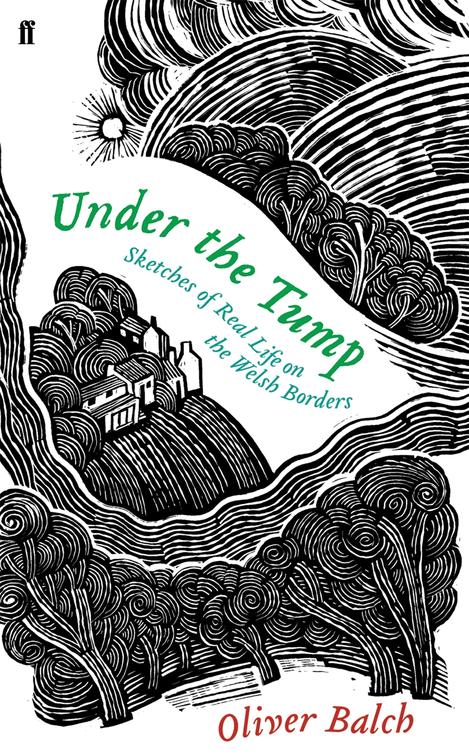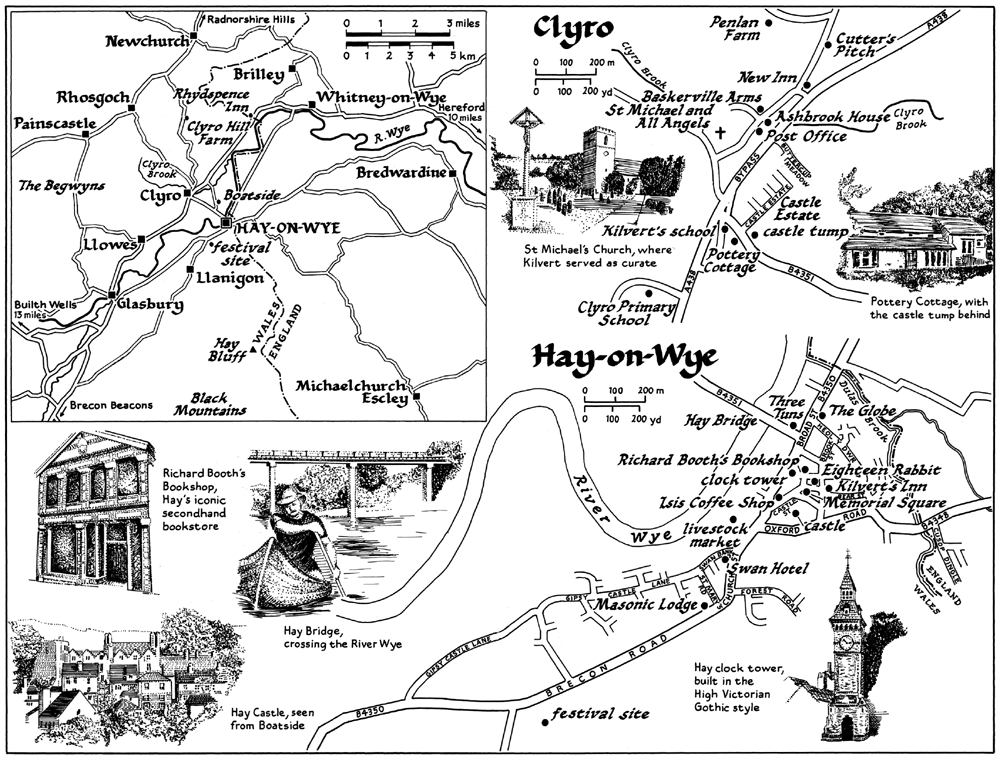Under the Tump
Authors: Oliver Balch



OLIVER BALCH
Sketches of Real Life
on the Welsh Borders

I fy meibion, Seth a Bo, gyda fy holl gariad
The people of Clyro are still sufficiently Welsh to be suspicious of strangers, and an Englishman would probably not be thoroughly liked and trusted till he had lived for some years in the country. But there is not in Radnorshire the same hostility and bitterness of feeling that is shown towards the Saxon in many parts of Wales. In fact the people, as a whole, are singularly civil, courteous and obliging, and this pleasant characteristic is not merely superficial, for to those who are kind to them they are demonstrative and really affectionate.
Reverend Francis Kilvert
(Curate of Clyro, 1865–1872)

Born near Chippenham, Wiltshire, on 3 December 1840, Robert Francis Kilvert was educated under his uncle’s tutelage at Bath and later at Wadham College, Oxford.
The son of a vicar, he served a brief stint as curate in his father’s parish in Langley Burrell, a few miles from his birthplace, before becoming curate of the village of Clyro in Radnorshire. In 1872, after seven years in the Welsh borders, he returned to Wiltshire. Four years later he was back in Radnorshire as vicar of St Harmon, before taking up the living of Bredwardine in Herefordshire the following year.
In August 1879 he married Elizabeth Ann Rowland, but only one month later, with the wedding decorations still hanging in the trees, Kilvert died of peritonitis. His body lies close to the banks of the River Wye, in the graveyard of Bredwardine’s parish church.
In early 1870 Kilvert began keeping a diary, the many volumes of which would pass to his widow and, later on, to a niece. After some judicious censorship by his relatives, a collection of his journals came into the hands of William Plomer half a century after Kilvert’s death. Plomer, a young editor at Jonathan Cape, published during 1938–40 an edited version in three volumes. A single-volume abridged edition,
Kilvert’s Diary, 1870–1879
, appeared in 1944.
In 1948 the still-flourishing Kilvert Society was established with the aim of fostering future interest in the acclaimed Victorian diarist and the rural life he wrote about so fondly.
We sat to take our luncheon upon the turf of the Beacons beside a tinkling rivulet … A sweet fresh wind was moving upon the hills and brilliant gleams of green and purple cloud shadows were flying upon the great landscape. In the narrow green sunny lanes the nuts still hung from the hazel tree and a small farmer driving a herd of fat red oxen put us into the right way with the beautiful courtesy of Radnorshire.
Kilvert’s Diary
, 14 September 1874
‘Don’t wait there. Knock and come in,’ the farmer’s wife says, her tone both forthright and welcoming. ‘You’re in Radnorshire now.’
I step through the doorway of her hilltop farmhouse, my arms bubbling with goose pimples from the cold. It is our first day in her holiday cottage and I sense her appraising me.
I was thinking about going for a jog, I tell her, standing there in my running shorts and trainers. Could she recommend a possible route? Her bemusement intensifies, my question sending her eyebrows arching upwards. The effect is discomfiting.
‘You know we’re on the top of a hill?’ she says. I do, I tell her. ‘Like running downhill, do you?’ I nod. ‘And uphill?’ No, uphill I’m less keen on, I have to admit, and we both
laugh, which helps break the ice and bring her eyebrows back down.
A few minutes later, I am heading along the road at the end of the farmyard with a sketched map in my hand. After a gradual descent, I bear off down a narrow country lane that is barely wider than a car. A thick hedgerow lines its bends and blind corners, its back and sides clipped by tractor flails into a mile-long crewcut. The luge-track road has no verge and I silently pray that no vehicle comes the other way.
The height of the hedges restricts my view of the surrounding countryside. I have to wait for the farm gates to catch glimpses through the gaps, although, with my fitness levels not what they should be, I am mostly focused on just keeping going. Having grown up in the flatlands of East Anglia, hill-running is an unwelcome novelty. We don’t do steep.
I am a mediocre runner and ten minutes in I am struggling. After the initial descent, the road began to climb. So far, it hasn’t stopped. My legs are heavy, my chest tight, my heart pounding.
My body wants to stop. This same urge creeps up on most runs, although seldom so close to the start and rarely with such insistence. I really, really want to stop. The road peaks about 400 yards ahead. I’ll rest when I get to the top, I tell myself. With leaden steps, I stagger on.
There, at the crest of the hill, I stop. Bent over, hands on my knees, I gasp for breath. A gusty wind generously tries to revive me. Not until I straighten up do I realise how strong it is. The hilltop is exposed on every side, the hedgerows stopping further down the slope. I glance down at the map, which reveals a sharp corner, next to which is etched
the somewhat chilling pair ‘Cold Blow’.
‘You’ll guess it easy enough,’ the farmer’s wife had said. Leaning on a nearby fence post, I think I’ve located it.
My lungs still straining, I look around me. In the foreground, fields of billiard-baize green stretch out on every side. The weather in the Marches is flighty. Gun-grey and inclement one moment; cloudless, azure skies the next.
The one constant is green, the colour of hope, of spring, of new life. Almost every type of green imaginable is on show. The greens of grass and leaf, fern and lichen, weed and shrub, moss and plant, all woven together in a chlorophyllous patchwork without stitch or edge.
Each field houses its own population of sheep, woolly white cue balls unruffled by the wind. To my left, in a sag just below the ridge line, the sheep are sharing their quarters with a herd of pedigree Hereford cattle, handsome brown-suited creatures with white tabards fastened to their chests.
Riding the thermals above is a fork-tailed red kite, its feathered limbs spread wide, on its aerial prowl for lunch. As I watch it swirl and turn, my eye is drawn to the backdrop behind it, where a spectacular crescent of corrugated escarpments frames the far horizon, a jagged zip-fastener binding earth to sky.
The mountains sweep upwards from the east, a surging wave of rock and scree erupting from the languid seabed flats of the Wye valley. Having scurried to the top, they cruise for a while, creating a knobbly plateau that continues for several miles. Then, as though the ancient river were calling them back, they tumble downwards to the rich grasslands below. Today the Black Mountains are dressed in cerulean blue.
After a short sprint across the lowlands, the Black Mountains give up the chase. On the muddied banks of Llangorse Lake, under the gaze of Afanc, the horse-headed Monster of Llyn Syfaddon, they hand over the reins. Seizing their chance, the Brecon Beacons take up the race and bound off to the south in a denture-shaped arc. Poking up through the mountains’ rocky skin, the stubby tips of two tiny milk-teeth jut upwards. Corn Du and Pen y Fan, the highest points in southern Britain.
The wind is blowing directly in my face and beginning to make my eyes water. I turn to gaze out in the opposite direction, where the hills are closer yet more outstretched, as though anxious to get away and beat a rolling retreat into the heart of Wales proper. Each hill folds into the next, gently heading westward in a lapping tide towards the country’s watery edge.
These are the Radnorshire hills, bare-backed and weather-smoothed. Down in the nearest valley trough below, an ancient line of Celtic outposts clings to the banks of the Bachawy brook. Rhosgoch, Llanbedr, Painscastle, Bryngwyn. Villages of sturdy homes built in ashlar stone, accustomed to damp and shy of the sun.
On the higher land, signs of human habitation are scant. The dark smudge of a farmstead occasionally blots the hillside. Otherwise, it’s open fields and barren moorland tops, mile upon mile of heather and sedge and sheep. Endless sheep. Noses always downward, diligently strimming the earth one patch at a time.
I turn right and set off westward from the cloud-high crossroads. The wind is on my back and almost straight away I am plunging downwards along a steep slalom slope to the Bachawy below. At the bottom, another back road
takes me north towards the village of Newchurch and the prospect of English soil underfoot.
I keep a steady pace for a few miles, the residual charge from the mountain views bringing a modicum of life back to my legs. Before I reach the border, I take a turning off to the right beside an abandoned phone box, which has me doubling back up a vertiginous pitch to the farm where I started. It is a cruel climb to end on. I check the map, now smeared with sweat. The ‘X’ marking the farmhouse still looks a fair way off. I will have to walk.
*
Some weeks later I buy a map of the immediate area. Unfolding it on the table of our hillside rental cabin, I trace my finger along the route I ran that first afternoon. I locate the farm and Cold Blow, Rhosgoch and the fearsome final slope.
Lured by the open space on the page, I imagine alternative routes further afield. The names of hills perched above narrow contour squiggles speak of a wild hinterland: Aberedw, Glascwm, Rhulen, Llandeilo, Gwaunceste.
The designation
Tumulus
appears next to each. The term is both italicised and capitalised, as though its subject is special yet somehow in doubt. Other similarly shadowy references dot these roadless voids. Words like
Castell
and
Standing Stones
and
Pillow Mounds
. Princelings’ forts and Druids’ rites fill my imagination. It would be months before I put on my trainers and braved any of these hill-strewn wastelands in person.
I continue drawing a line northwards until I reach the top of the map. It finishes after about fifteen miles, near a
farm called Bwlch-y-cefn Bank. The isolated hill farm neighbours another farm called Bwlch-llywn Bank, which is just above another settlement called Bwlchau. I study them closely. Balch and Bwlch. I wonder if our paths might have crossed before.
Ten or fifteen miles beyond the edge of the map lies the Ithon valley. Fast and plucky, the River Ithon takes its name from the Welsh
eithon
, meaning ‘talkative’. A major left-bank tributary of the River Wye, it rises in the uppermost reaches of Radnorshire, in the saddle between the Kerry Ridgeway and the wonderfully Tolkeinesque Hill of Glog. From these mythological beginnings, the Ithon twists and chatters its way south towards its broad-banked parent and the ebbing tides of reality.
Close to the mouth of the Ithon, a few miles from the riverside village of Llanbadarn Fynydd, is a large, square-jawed house called Pen Ithon Hall. It stands on its own at the end of a long driveway lined with sycamore sentries. My parents first took me there when I was six months old and I have been back on holiday every year since. As young children, my brother and sister and I would spend our days roaming outside in the sprawling grounds, making dens and building dams, kicking cowpats and flying kites. Now I look on as my own two boys, Seth and Bo, aged five and six respectively, do the same.
It is the landscape of rural Radnorshire that I had foremost in mind when my wife Emma and I decided to move. We had left London for Argentina shortly after we were married, setting off in search of something new, determined to spread our wings before they were clipped by jobs and mortgage payments and rush hour on the Northern Line.
We told ourselves we’d go for just a year. We ended up
staying seven. Throughout that time, Argentina constantly veered and wobbled, as is the country’s wont. At a personal level, however, life remained good. We travelled, we made friends, we bought a house, we had our two boys. It’s true that we mostly lived hand-to-mouth, but we kept our outgoings low and our responsibilities were few. In the round, there were far more years of feasting than famine. It helped that the sun shone and the music played, of course.
Then, very naturally, it felt as though our adventuring abroad had run its course for the time being. The boys were approaching school age and I realised I wanted them to experience something of what I had known as a child, with the white Christmases and changing seasons, the FA Cup Saturdays and Sunday walks to the pub.
This urge to return came with a conundrum. Where exactly to move back to? Our work is such that we can live anywhere as long as we have a phone line and internet access.
Going back to where we had grown up – Yorkshire in Emma’s case, Essex in mine – would have been the most obvious choice. But neither of us had lived there since leaving school almost two decades ago, and we had few friends left in either area.
That wasn’t always the case. At primary school I knew everyone my age in our village. Then, when I was nine, I got sent to a private school in a nearby town and everything gradually changed. I clung on to a few of my old friends for a while: Nick Middleton on Queen’s Street, whose mum was friends with my mum; Simon Ashby on Tey Road, who won a racing bike in a raffle and whom I’d go on cycle rides with.
Then, aged thirteen, I went to boarding school and my
ostracism became complete. My friends in the village became fellow exiles returning home from various educational outposts with their social lives packed into their school trunks, padlocked shut, ready to be resumed with the start of term. I am still in touch with several of them today, but they are scattered all over the place now. Just as we were then.
Our parents continue to live where we grew up and, friends or no friends, I liked the idea of our boys being close to their grandparents. Yet Essex and Yorkshire are half a country apart, and choosing one would inevitably mean rejecting the other. The potential for a snubbed set of grandparents seemed high.
Other question marks hung over returning to our childhood homes. In the case of my parents, it was their proximity to London. Being within an hour by train from the capital put house prices way out of our budget. For Emma, it was the weather: she wasn’t sure she could face another Yorkshire winter.
Added to the mix was an urge that had been slowly growing in me for a change of scenery. I had lived in cities ever since leaving school, and so much brick and concrete was getting to me. I fancied living somewhere with open skies and fresh air; somewhere I could strap on my walking boots and head out for a hike; somewhere alive to the sound of birdsong rather than bus exhausts. I envisioned the same for the boys. Growing up in wellies and with muddy knees. Weekend camping trips. Swimming in the river. Somewhere like Pen Ithon.
In this respect, Yorkshire’s empty enormity fitted the bill far more closely than the overpopulated flatlands of Essex. This attraction to the countryside and the outdoors is more
mine than Emma’s, however. I could see us living in a remote spot in Nidderdale, say, or on a protected patch of moorland in the Cleveland Hills. Emma’s natural inclinations are distinctly more urban. She feeds off cities and their endless possibilities. Buenos Aires, with its sleepless nights and its creative madness, kept her well sated.
There is much that Emma and I disagree on. Yet on the big-ticket items, the stuff that really matters in a marriage, we’re of one mind. One of our core mutual convictions is that an interesting life beats a secure one. Life is short. More than half our three score and ten is already behind us. We’d rather risk the unknown than keep to the same. That’s what excites us, pushes us to grow, keeps us learning.
It’s for this reason that I felt I could moot the idea of Radnorshire and harbour a modicum of hope that Emma might agree.
I brought up the subject casually, all the same. And with various caveats too. For starters, instead of the relatively restrictive confines of Radnorshire, I proposed Powys as a possible location.
Long and chunky, Powys’s eastern frontier runs beside the perimeter fence of the English border. Officially, the uncluttered bulge of Radnorshire, squashed between flat-pan Herefordshire to the east and coast-bound Cardiganshire to the west, was subsumed into this larger administrative unit in the mid-1970s. Bundled in along with it were its neighbours Montgomeryshire and Brecknockshire. Today, Powys’s far-reaching boundaries cover much of what is popularly referred to as the Welsh Marches.